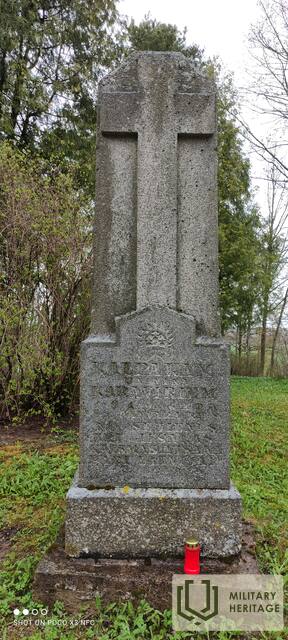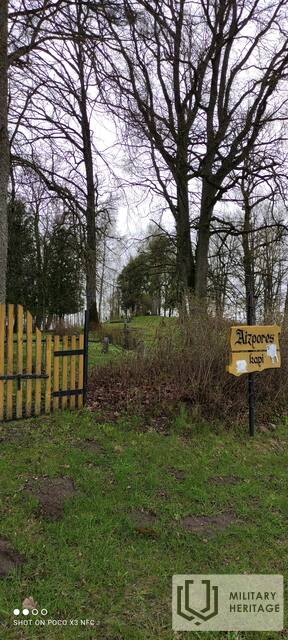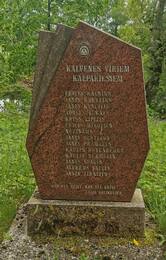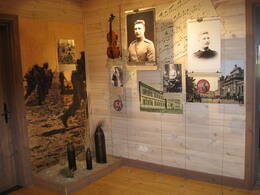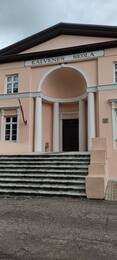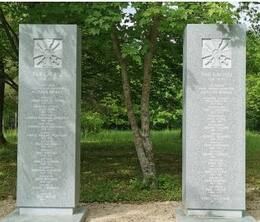Aizporių dvaras Nepriklausomybės kovų metu
Aizporų pusdvaras, Aizputės rajonas, Kalvenės savivaldybė, yra vakariausia Latvijos vieta, į kurią atsitraukė pulkininko Oskaro Kalpako atskirasis batalionas.
Pusiaukelėje tarp Rudbāržių ir Kalvenės, pakelėje, yra Aizporės kapinės. Jose stovi paminklas ir 12 atminimo ženklų Oskaro Kalpakos bataliono savanoriams kariams.
1919 m. sausį, palikęs Jelgavą per Lielaučius, kur vyko pirmasis Nepriklausomybės karo mūšis, pulkininko Oskaro Kalpako batalionas, perplaukęs Ventą, pasiekė Lėnos ir Rudbāržių dvarus. Sausio 22 d. ankstų rytą pulkininko O. Kalpako batalionas užėmė gynybines pozicijas Liepojos–Jelgavos plento ir Embūtės–Valtaikių kelio sankryžoje AIZPORU dvaro teritorijoje. Kairėje buvo Pabaltijo landesvero pajėgos, dešinėje – vokiečių Geležinė divizija. Kadangi tolesnis sovietų Latvijos pajėgų puolimas iš Skrundos nevyko, O. Kalpako batalionas grįžo į ankstesnes pozicijas netoli RUDBĀRŽI dvaro.
1922 metais buvę Kalpako bataliono vyrai pastatė laikiną paminklą – ąžuolinį luitą su varine lenta.
Ketvirtajame dešimtmetyje O. Kalpako draugija užsakė skulptoriui Jāniui Briediui sukurti paminklą „Pradžia“, o didelio memorialinio komplekso su pasodintu ąžuolu – Didvyrių alėjos – Rudbāržių dvare idėją propagavo ir priėmė Latvijos prezidentas. Teisę įrengti memorialinę vietą įsigijo skulptorius Kārlis Jansons.
Kadangi pagrindiniai paminklo sukūrimo finansuotojai yra Studentų korporacijos, 1939 m. gegužės 15 d. pagamintas J.Briežo paminklas buvo įrengtas Pinkuose (restauruotas paminklas yra Pinkuose) O.Kalpako batalionui priklausančios Studentų kuopos garbei.
1940 m., okupavus Latviją, memorialinės vietos įrengimo planai buvo sustabdyti. Neoficialiais duomenimis, suplanuota Didvyrių alėja buvo iš dalies įgyvendinta pasodinus ąžuolus nuo Rudbāržių dvaro Aizporų kryptimi ir šiandien matoma netoli Liepojos–Rygos plento.
Moderni memorialinė vieta
Atkūrus Latvijos Respublikos nepriklausomybę 1993 m. gegužės 15 d., buvo atidengtas atminimo ženklas – Šviesos spindulys. 2,3 m aukščio atminimo ženklą, iškaltą iš pilko granito, sukūrė skulptoriai Harijs SPRINCIS ir Imants LUKAŽIS (1930–2007, palaidotas Aizpori kapinėse), kurio tėvas taip pat buvo O. Kalpako bataliono karys. Atminimo ženkle iškalti poeto Ed. VIRZO žodžiai:
DIENAI
IR JI
KARIEMS
1919 m.
Sausio 25 d. rytas
IŠ ČIA
TAIP PAT PRADĖTA
AUDIMO ŠVIESA
PORA LATVIJAI
Šaltiniai: Lismanis, J. 1915–1920. Mūšių ir žuvusių kareivių atminimui: Pirmojo pasaulinio karo ir Latvijos išsivadavimo kovų memorialinės vietos. Ryga: NIMS, 1999. p. 177.
Susijusi laiko juosta
Susijusios temos
Susijusios vietos
Paminklas ir atminimo ženklai O. Kalpakos bataliono kariams Aizporės kapinėse
Maždaug pusiaukelėje tarp Rudbāržių ir Kalvės, seno kelio, lygiagretaus greitkeliui A9, pakraštyje yra Aizporės kapinės.
Aplinkiniuose namuose gyvenusiems Oskaro Kalpakos bataliono savanoriams kariams pastatytas paminklas ir 12 atminimo ženklų.
Kalvenės savivaldybės Aizporės pusdvaris buvo tolimiausia vieta, į kurią 1919 m. sausio 22 d. atsitraukė Latvijos atskirasis (Kalpakų) batalionas. Čia batalionas gavo pirmąjį pastiprinimą iš Liepojos – 35 vyrus ir pradėjo kontrpuolimą, sausio 24 d. pasiekdamas Rudbāržius.
Paminklo pastatymo idėja kilo dar 1920-aisiais, kai buvę 1-ojo Latvijos atskirojo bataliono, arba Kalpakos bataliono, kariai pastatė laikiną atminimo ženklą – ąžuolo luitą su lenta. Tuo metu gimė idėja sukurti didesnį memorialinį ansamblį, tačiau ji buvo įgyvendinta tik 1993 m. gegužės 15 d., kai buvo atidengtas atminimo ženklas – Šviesos spindulys – obeliskas iš pilko granito.
2,3 m aukščio atminimo ženklą sukūrė skulptoriai Harijs SPRINCIS ir Imants LUKAŽIS (1930–2007 m., palaidotas Aizpuri kapinėse), kurio tėvas taip pat buvo O. Kalpakos bataliono karys. Atminimo ženkle iškalti poeto E. VIRZOS vardai:
KALPAKAM
IR JO
KARIEMS
1919 m.
Sausio 25 d. rytas
NUO ŠIOS DIENOS
TAIP PAT IŠ
UGNIS
VIRŠ LATVIJOS
Tuo pačiu metu 12 kapinėse palaidotų Kalpų kapai buvo pažymėti ąžuolinėmis atminimo lentomis, kurios 2019 m. pakeistos granito žymekliais.
Dešimtojo dešimtmečio pradžioje kapinėse buvo pastatytas dviejų metrų aukščio paminklas, šalia kurio auga legendinio aktoriaus Ēvaldo Valterio dešimtojo dešimtmečio viduryje pasodintas ąžuolas.
Skrundos mūšio memorialas ir vėliavos diena
Skrundos mūšio memorialas yra Skrundos centre, Oskaro Kalpakos parke netoli Skrundos kultūros namų, Kuldygos ir Liepojos gatvių sankryžoje. 2005 m. prie memorialo buvo pastatytas akmuo, skirtas 1919 m. sausio 29 d. mūšiui atminti, kai Oskaro Kalpako vadovaujamas batalionas kartu su vokiečių ir rusų Landesvero daliniais išvadavo Skrundą nuo bolševikų. Vėliavos dienos tradicija tęsiama nuo 2004 m., minint pirmąjį iš bolševikų išlaisvintą miestą ir jo išvaduotojus, kurie 1919 m. sausio 29 d. Skrundos bažnyčioje iškėlė Latvijos vėliavą.
Pirmaisiais Nepriklausomybės karo mėnesiais Latvijos laikinoji vyriausybė, spaudžiama bolševikų, sparčiai prarado teritoriją. 1919 m. sausio 22 d. bolševikai užėmė Skrundą. Po savaitės, sausio 29 d., ankstyvą rytą, prasidėjo puolimas Skrundai atsiimti. Latvijos atskirasis batalionas, vadovaujamas pulkininko leitenanto Oskaro Kalpako, turėjo pulti Rudbāržu-Skrundos plentu ir išstumti bolševikus iš Skrundos. Po to turėjo vykti vokiečių dalinių flanginis puolimas, kurio užduotis buvo sunaikinti artėjantį priešą, o rusų kuopa turėjo pulti tarp Latvijos ir Vokietijos dalinių, orientyru naudodama Skrundos bažnyčią. Puolimą taip pat rėmė vokiečių artilerijos baterija. Puolimo dieną buvo 15 laipsnių šalčio, švietė ryški saulė, kalpakai turėjo kirsti giedrą lauką, o bolševikai slėpėsi dvaro akmeniniuose pastatuose. Bolševikai atidengė ugnį, kai užpuolikų grandinė buvo nutolusi apie 300 metrų, kilo abipusis susišaudymas, ir Oskaro Kalpako vadovaujami kareiviai sparčiai puolė į priekį, priversdami priešą nutraukti ugnį ir trauktis per Ventą. Po maždaug 3 valandų kovos Skrunda buvo užimta apie 9 val. ryto, Latvijos atskirajame batalione buvo sužeisti tik 2 kariai.
Skrundos mūšis turėjo didelę reikšmę Latvijos laikinosios vyriausybės ginkluotų Speko karių moralei, nes tai iš tikrųjų buvo pirmoji reikšminga pergalė mūšiuose prieš bolševikus. Be to, pats vadas Oskaras Kalpakas mūšyje demonstravo ypatingą drąsą, savo pavyzdžiu skatindamas karius nebijoti.
Oskaro Kalpako muziejus ir memorialinė vieta „Airītes“
Oskaro Kalpako muziejus ir memorialinė vieta „Airītes“ yra tarp Saldaus ir Skrundos, netoli greitkelio A9. Parodoje pateikiama išsami informacija apie pulkininką Oskarą Kalpaką ir jo batalioną, taip pat pristatoma Latvijos nacionalinės armijos ir memorialinės vietos „Airītes“ istorija. Parodoje pulkininką Oskarą Kalpaką pristatoma kaip asmenybę, kaip karį ir kaip kovotoją už Latvijos nepriklausomybę. Parodoje taip pat yra garso įrašų latvių, anglų ir vokiečių kalbomis. Juose pabrėžiama 1918/1919 m. istorinių įvykių svarba saugant Latvijos valstybingumą. Muziejaus pastatas yra restauruotas.
Įėjimas nemokamas; ekskursija su gidu – mokama. Komplekse yra poilsio zona, parkas, kliūčių ruožas, galima lankyti įvairius užsiėmimus, yra seminarų salė iki 30 žmonių.
Tašas - Padurės dvaras
Tasi-Padurės dvaro pilis dabar žinoma kaip Kalvenes pradinė mokykla, įkurta 1922 m. Mokyklos pastatas buvo pastatytas XIX a. vėlyvojo klasicizmo stiliumi kaip grafo Keizerlingo medžioklės namelis.
1919 metų pradžioje čia susirinko ir į dvarą atvyko pirmieji į mobilizacijos šaukimą atsiliepę mobilizacijos vyrai. 1919 metų sausio 22 dieną čia buvo įkurtas Latvijos atskirasis kavalerijos dalinys, kurio vienas vadų sausio 24 dieną išvyko į O. Kalpakso vadovaujamą 1-ąjį Latvijos atskirąjį batalioną. Visas dalinys (iš viso apie 80 kareivių), vadovaujamas vado Arnoldo Artumo-Hartmanio, į Rudbāržius atvyko kovo 1 dieną.
Kalvenės pradinė mokykla yra nacionalinis kultūros paminklas. 1960-aisiais pilis buvo renovuota ir pritaikyta mokyklos poreikiams.
Stelos Lačplėsio karo ordinų riterių atminimui
Su Aizputės regionu susiję dvidešimt septyni Lačplėsio karinio ordino riteriai.
Pagerbiant Latvijos Nepriklausomybės kare žuvusius karius, visoje Latvijoje buvo įrengtos vienodo modelio memorialinės stelos, kuriose teksto graviravimo šriftas atitinka didvyrių atminimo lentų standartą, analogišką Rygos brolių kapinių ir Centrinių kapinių lauko smiltainio atminimo ženklų graviravimui.
Granito stelos buvo sukurtos įgyvendinant Jaunosios gvardijos ir informacijos centro projektą „Prisimink Lāčplēšį“, skirtą Latvijos valstybės šimtmečiui.




